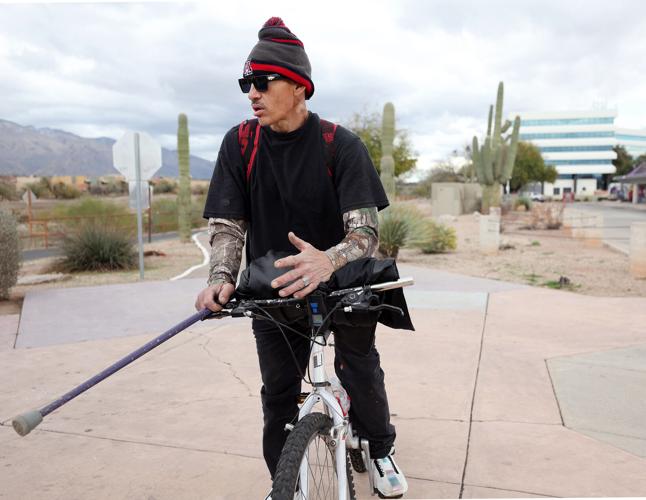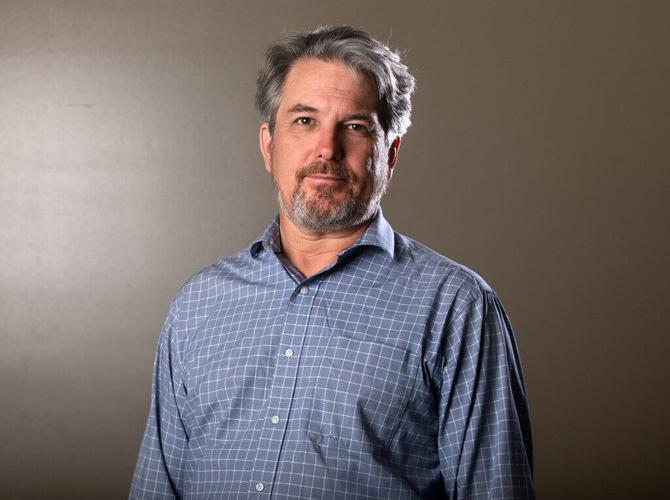Sporadically all day, cyclists ride The Loop trail along the Rillito and come up against a closed gate.
The gate stops cyclists and walkers from going under the North Stone Avenue bridge and west past Tucson Mall, though you can clamber through it. The quarter-mile gap by the mall is one of the few left in the celebrated path built by the Pima County Regional Flood Control District.
Truth be told, it’s a good thing people can’t go further — at least as conditions stand now. There’s nothing but trash and mud down beneath the bridge, and, Thursday afternoon, a man who was bent over at the waist, hanging down like he was doing yoga, though it was probably the effects of the “blues” — opioid pills that have a grip on so many people.
This area near Tohono Tadai bus station is one of the trouble spots along the Tucson area’s justly celebrated Chuck Huckelberry Loop. In this area, people have congregated to sell and do drugs and sometimes have set up camps to live in, though conditions have been better in recent months.
Some of the same qualities that attract so many riders, runners and walkers also attract people doing drugs and looking for a place to sleep or pass out. Much of the Loop is near the services of the city — the stores, the streets the bus routes, the bathrooms — but set apart. It’s protected from cars, near the wild corridors of the riverbeds and washes, and open to great views of the surrounding mountains.

Arizona Daily Star columnist Tim Steller
It’s a great place to bike and a convenient place to do heavy drugs if you’re caught in that habit.
Damion Alexander rides the loop daily and is a big fan and promoter of the trail. But he knows weird things can happen in the few areas frequented by drug users.
“I was riding by some people and I slowed down,” Alexander recalled. “A guy stood up, right as I went by, blew out, and I took in a full mouthful of something that made me queasy, then my face started to tingle.”
When out-of-town friends come into town, he cautions them against riding near two areas: The Tucson Mall and the east side of the Santa Cruz River, from about Grant Road to south of Congress.
“Anyone who’s visiting I’m like, those are the two areas where you should just go to the other side,” he said.
The Loop’s trouble spots
But even the north side of the Rillito near the Tucson Mall, and other areas farther away, sometimes presents unpleasant obstacles or experiences.
Larry Morgan was riding westbound on the north side of the Rillito June 23, wearing dark glasses in the bright sunshine. When he went under the Stone Avenue bridge, he said, he suddenly saw a group of men and a bicycle lying across the path.
“I hit the bicycle, went over the handlebars, went over his bicycle, and onto the pavement,” Morgan recalled. “There were 5 or 6 homeless guys there.”
One of the men helped him up, to lean Morgan over a fence, but that was the extent of their help, he said. Morgan ended up yelling at passersby on the bridge above, asking for a phone to call for help. It took at least 90 minutes to get him help for what turned out to be a broken femur, broken collarbone and three broken ribs.
Morgan acknowledges he was going somewhat fast — 15 mph or so — when he went under the bridge, and the abrupt change of lighting was also a factor. Speed is a common theme in collisions on The Loop. But nothing would have happened if there weren’t a bike strewn across the path, too.
I don’t want to give off a false impression of The Loop — it’s mostly great. Even in the one other area where people have set up camps recently, along Barraza-Aviation Highway, there are fewer reports of conflicts.
But people have come across some pretty ugly stuff while on The Loop. That became clear when the county’s social-media team asked on Facebook last week what the weirdest thing is that Loop users have seen.
Most of the answers dealt with the behavior of drug users and campers: People passed out across the path, people defecating, people having sex, and of course, people doing drugs.

Bobby Barnell says he rides his bike along the Tucson Loop near the Tucson Mall almost daily in Tucson, Ariz., on Feb. 8. Homelessness and people with addiction problems are a frequent sight for walkers and cyclists using the Tucson Loop.
One of the Loop riders who answered, Randy Jardee, said his big fear is running over someone in the path. He’s come across such people twice when riding the Loop at night, which, he acknowledged is against the rules. So is lying across the path at night, he noted.
“I’d hate to injure someone. And I’m sure they’d hate to be ran over,” he told me via Facebook.
Bike patrols cut drug dealing

Trash and other debris lay on the Rillito River along the Tucson Loop near the Tucson Mall in Tucson, Ariz., on Feb. 8. Homelessness and people with addiction problems are a frequent sight for walkers and cyclists using the Tucson Loop.
City and county officials have made some progress in the area around Tucson Mall. The situation there, Council Member Kevin Dahl said, “is not so much about homelessness — it was an open-air drug market.”
Dahl’s office used its discretionary budget to pay for bike patrols in the area, first for a three-month pilot project, then for another three months. It made a difference.
When I spoke to people at Tohono Tadai over the last two weeks, most said the area is more orderly than it was months ago.
“Bike cops were much more effective than police patrols in cars,” Dahl said via email. “The officers could survey from a distance and ride right up on a transaction almost before the drug dealers and customers were aware they were there.”
But sometimes jurisdictional issues come up. While the Loop was built by the flood-control district, much of it is within the city of Tucson or other incorporated towns. Sometimes one jurisdiction wants another to respond.
“It adds to the complexity,” said Eric Shepp, who is director of the flood control district and a friend of mine. “We have to figure out in which jurisdiction the activity is and ask the appropriate law enforcement.”
Around the Rillito, the geography is especially tricky, with county and city responsibilities for adjacent roads and paths. The county has parks employees who are dedicated to patrolling and maintaining The Loop, and the flood control district has spent $200,000 to $300,000 per year on clean-ups.
“We have a process where we go around the regional watercourses and clean up camps,” Shepp said. “The complaints are from folks on The Loop, so we get a lot of attention on The Loop.”
Mall presents roadblock
As long as drug abuse remains pervasive, there will probably be some bad encounters on The Loop. But there is a school of thought that more legal activity in places like the Tucson Mall area — more cyclists, walkers and runners — will discourage the illegal or problematic behavior.
The problem, in the mall area, is that the mall itself owns the land all the way up to the edge of the Rillito’s south bank. Because that’s private property, the owners of the land and the management company operating the mall would both have to approve of extending the loop along the north edge of the mall parking lot.
The flood control district made such a proposal early last year. The simple, reversible solution would be to make the outer lane of the four-lane road that runs along the edge of the mall parking lot into an extension of the Loop, perhaps separated by barricades.
The land owner approved, but mall management so far has not. That leads to scenes like one that photographer Mamta Popat and I saw Thursday, when a spandex-clad father and child from Ohio found themselves stopped against the gate, gazing down under the Stone Avenue bridge, wondering where to go.
They asked us for directions to continue west, and we pointed them across Stone and through the Mall parking lot.
A more regular, local rider, Bobby Barnell, said “it’s a hassle” to always cross Stone on his regular route. He’s constantly aware of getting hit by cars.
“I try to avoid parking lots,” he said. “I’d rather go under the bridge.”
Whether bridging that gap will dilute the problematic interactions in that area, we can’t know until we try. A reversible solution strikes me as one worth trying.
The broader problems of drug abuse and occasional conflicts with riders around The Loop, though, are just going to take the kind of sustained effort that helped out near Tucson Mall and Tohono Tadai station. More eyes, more reports, more official responses without regard to jurisdictional boundaries.
That ought to at least keep these problems from breaking what makes The Loop so successful.
Get your morning recap of today's local news and read the full stories here: tucne.ws/morning








